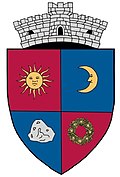Mociu
|
Mociu Motsch MOCs |
||||
|
||||
| Basic data | ||||
|---|---|---|---|---|
| State : |
|
|||
| Historical region : | Transylvania | |||
| Circle : | Cluj | |||
| Coordinates : | 46 ° 48 ' N , 24 ° 2' E | |||
| Time zone : | EET ( UTC +2) | |||
| Height : | 357 m | |||
| Area : | 73.41 km² | |||
| Residents : | 3,313 (October 20, 2011) | |||
| Population density : | 45 inhabitants per km² | |||
| Postal code : | 407420 | |||
| Telephone code : | (+40) 02 64 | |||
| License plate : | CJ | |||
| Structure and administration (as of 2016) | ||||
| Community type : | local community | |||
| Structure : | Mociu, Boteni , Chesău , Crișeni , Falca , Ghirișu Român , Roșieni , Turmași , Zorenii de Vale | |||
| Mayor : | Vasile Focșa ( PNL ) | |||
| Postal address : | Str. Principală, no. 26 loc. Mociu, jud. Cluj, RO-407420 |
|||
| Website : | ||||
| Others | ||||
| City Festival : | 1st Sunday in September, "Cântecul de pe Câmpie" (The song in the plains ) | |||
Mociu ( German Motsch , Hungarian Mócs ) is a municipality in the Cluj district , in the Transylvania region in Romania .
Geographical location
The municipality of Mociu is located in the Transylvanian Heath (Câmpia Transilvaniei) - part of the Transylvanian Basin - in the east of the Cluj district. The place Mociu is located on the creek of the same name, a left tributary of the Fizeș and on the national road 16 23 kilometers northwest of the small town Sărmașu ( Mureș district ), and about 40 kilometers east of the district capital Cluj-Napoca (Klausenburg) .
history
The place Mociu was first mentioned in documents in 1219 or 1329, according to different sources. To a settlement of the region to the Early Bronze Age suggest, according to M. Roska archaeological discoveries east of the community center, called by the locals of the area Ocolis to the Latènezeit back.
In the Kingdom of Hungary , today's community center (Mocs) was the headquarters of a chair district in the Cluj- Napoca County . Subsequently, the municipality belonged to the historical Cluj District and from 1950 to the present Cluj District.
On February 3, 1882, the largest meteorite in Romania fell in the area of the Mociu municipality . The largest piece of the meteorite - 35.7 kilograms - was found on the area of the community center; remaining parts found within a radius of 15 kilometers. 42 kg of the meteorite are in the Museum of Mineralogy (Muzeul de Mineralogie) in Cluj-Napoca and numerous smaller parts have been distributed in over 100 museums worldwide. The meteorite is said to have weighed around 300 kilograms.
population
The population of the municipality developed as follows:
| census | Ethnic composition | ||||
|---|---|---|---|---|---|
| year | population | Romanians | Hungary | German | other |
| 1850 | 2,796 | 1.910 | 732 | - | 81 |
| 1920 | 4,527 | 2,977 | 1,334 | 5 | 211 |
| 1956 | 5,758 | 4.122 | 1,368 | - | 268 |
| 2002 | 3,494 | 2,589 | 595 | 1 | 309 |
| 2011 | 3,313 | 2.263 | 501 | - | 549 |
Since 1850, the highest number of inhabitants in the area of today's Mociu municipality was determined in 1956. The highest population of Romanians (4128) was determined in 1966, that of Magyars (1489) and Romanian Germans (90) in 1910, and that of Roma (371) in 2011.
The main occupations of the population are agriculture and livestock.
Attractions
- In the incorporated village of Boteni (Hungarian Botháza ), the reformed church built in the 13th century and renovated in the 17th, is a listed building.
- In the incorporated village of Chesău (outdated Cheşeu , Chişău ; Hungarian Mezökeszü ) the reformed church built in the 15th century and renewed in the 18th, at the same time the bell tower and the wooden church Sfinții Arhangheli Mihail și Gavriil , built in the 18th century, are listed.
- In the incorporated village of Crișeni (outdated Tăuthaza ; Hungarian Tótháza ) the wooden church Sfinții Arhangheli Mihail și Gavriil , built in 1791 and renewed in the 19th century, at the same time the bell tower was built, are listed.
Web links
Individual evidence
- ↑ 2011 census in Romania ( MS Excel ; 1.3 MB)
- ↑ Arcanum Kézikönyvtár: Historical-administrative book of place names of Transylvania, Banat and Partium. Retrieved December 5, 2017 (Hungarian).
- ↑ community Mociu: Informaţii generale. Retrieved December 5, 2017 (Romanian).
- ↑ Heinz Heltmann, Gustav Servatius (Ed.): Travel Guide Siebenbürgen . Kraft, Würzburg 1993, ISBN 3-8083-2019-2 , p. 517 .
- ↑ Institute Of Archeology: Mociu. cimec.ro, accessed December 9, 2017 (Romanian).
- ↑ a b c d List of historical monuments of the Romanian Ministry of Culture, updated 2015 (PDF; 12.7 MB; Romanian)
- ↑ Marius Septimiu Avram: The story of the Mociu meteorite, the largest in Romania. agerpres.ro, August 29, 2014, accessed December 9, 2017 (Romanian).
- ↑ Censuses 1850–2002, last updated November 2, 2008 (PDF; 1 MB; Hungarian)










